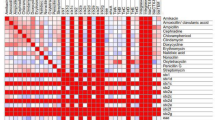Abstract
The anti-terminator Q933 gene of the bacteriophage 933W was evaluated as a marker for Escherichia coli O157:H7 strains with high Shiga toxin production. In total, 262 environmental strains of E. coli O157:H7 isolated from feces of beef cattle and the digestive tract of houseflies were screened for the Q933 and Q21 (anti-terminator Q21 of bacteriophage 21) genes by polymerase chain reaction. Nine (3.4%) isolates tested positive for Q933 alone, 161 (61.5%) were positive for the Q21 gene alone, and 92 (35.1%) isolates carried both Q alleles. Results from the enzyme-linked immunosorbent assay show that the isolates with Q933 alone produced significantly more Shiga toxin than the remaining isolates. The difference was even greater after the induction of the toxin production by a short exposure of cells to ultraviolet light. These data suggest that Q933 is a promising indicator for environmental E. coli O157:H7 with high production of Shiga toxins and, therefore, for potentially clinically relevant strains.

Similar content being viewed by others
Literature Cited
Alam MJ, Zurek L (2004) Association of Escherichia coli O157:H7 with houseflies on a cattle farm. Appl Environ Microbiol 70:758–7580
Alam MJ, Zurek L (2006) Assessment of seasonal prevalence and shedding of Escherichia coli O157:H7 in the feces of beef cattle. J Food Prot (in press).
Altschul SF, Gish W, Miller W, Myers EW, Lipman DJ (1990) Basic local alignment search tool. J Mol Biol 215:403–410
Bach SJ, McAllister TA, Veira DM, Gannon VPJ, Holley RA (2002) Transmission and control of Escherichia coli O157:H7: a review. Can J Anim Sci 82 475–490
Banatvala N, Magnano AR, Cartter ML (1996) Meat grinders and molecular epidemiology: two supermarket outbreaks of Escherichia coli O157:H7 infection. J Infect Dis 173:480–483
Fraser ME, Fujinaga M, Cherney MM, et al (2004) Structure of Shiga toxin type 2 (Stx2) from Escherichia coli O157:H7. J Biol Chem 279:27,511–27,517
Friedrich A W, Bielaszewska M, Zhang WL, et al (2002) Escherichia coli harboring Shiga toxin 2 gene variants: frequency and association with clinical symptoms. J Infect Dis 185:74–84
LeJeune JT, Abedon ST, Takemura K, Christie NP, Sreevatsan S (2004) Human Escherichia coli O157:H7 genetic marker in isolates of bovine origin. Emerg Infect Dis 10:1482–1485
Ludwig K, Sarkim V, Bitzan M, et al. (2002) Shiga toxin-producing Escherichia coli infection and antibodies against Stx2 and Stx1 in household contacts of children with enteropathic hemolytic-uremic syndrome. J Clin Microbiol 40:1773–1782
Matsutani S, Ohtsubo E (1990) Complete sequence of IS629. Nucleic Acid Res 7:1899
Matsutani S, Ohtsubo E (1993) Distribution of the Shigella sonnei insertion elements in Enterobactericeae. Gene 127:111–115
Mead PS, Griffin PM (1998) Escherichia coli O157:H7. Lancet 352:1207–1212
Nataro JP, Kaper JB (1998) Diarrheagenic Escherichia coli. Clin Microbiol Rev 11:142–201
Plunket GIII, Rose DJ, Durfee TJ, Blattner FR (1999) Sequence of Shiga toxin 2 phage 933W from Escherichia coli O157:H7 Shiga toxin as a phage late-gene product. J Bacteriol 181:1767–1778
Pradel N, Boukhors K, Bertin Y, Forestier C, Martin C, Livrelli V (2001) Heterogeneity of Shiga toxin-producing Escherichia coli strains isolated from hemolytic-uremic syndrome patients, cattle, and food samples in central France. Appl Environ Microbiol 67:2460–2468
Sanderson MW, Sargeant JM, Shi X, Nagaraja TG, Zurek L, Alam MJ (2006) Longitudinal emergence and distribution of Escherichia coli genetic strains in a beef feedlot. Appl Environ Microbiol (in press).
SAS Institute (2003) SAS OnlineDoc® 9.1. SAS Institute Inc., Cary, NC
Wagner PL, Neely MN, Zhang X, Acheson DW, Waldor MK, Friedman DI (2001) Role of a phage promoter in Shiga toxin 2 expression from a pathogenic Escherichia coli strain. J Bacteriol 183:2081–2085
Acknowledgments
We thank Jan Metlevski for technical assistance and Dr. David Margolies for reviewing the manuscript. This study was funded by the USDA grant 34359-13008. This is contribution No. 06-339-J from the Kansas Agricultural Experiment Station.
Author information
Authors and Affiliations
Corresponding author
Rights and permissions
About this article
Cite this article
Ahmad, A., Zurek, L. Evaluation of the Anti-Terminator Q933 Gene as a Marker for Escherichia coli O157:H7 with High Shiga Toxin Production. Curr Microbiol 53, 324–328 (2006). https://doi.org/10.1007/s00284-006-0089-3
Received:
Accepted:
Published:
Issue Date:
DOI: https://doi.org/10.1007/s00284-006-0089-3




